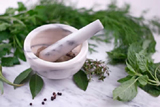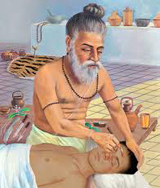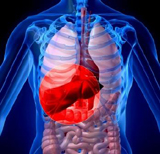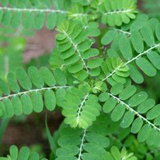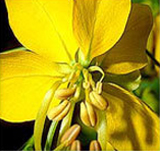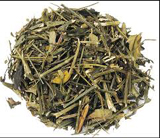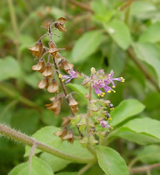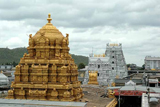Āyurveda
An overview of certain Āyurvedic herbs in the management of viral hepatitis
Editor's Note
Long before modern medicine came into existence, there existed in all countries a knowledge of herbs that helped in various ways. The very fact that humanity has survived critical transitions, wars and famines is itself empirical proof of the value of these herbs. Now that we are realising that modern medicine pays a heavy price, there is an attempt the world over to dig into the lost secrets. This search is not without difficulty. It is like learning an entirely new language. Our present knowledge sometimes becomes a bar. The ancients saw the world differently: they felt and experienced it in another way, a way we have lost but whose trail still lingers in our memory, energising us to undertake the same journey from our present point. This article tries to bridge a gap that is the need of the hour.
(This article was presented at the Japan Society of Hepatology http://www.jsh.or.jp/english/index.html ,in 2007).India is the third richest source of plant species after Brazil and China with over 1,500 species and occupies the highest position in the use of herbal drugs, utilising 500 plant species for various ailments. Following an increasing awareness and interest in nature cure, a large percentage of the Indian population at present consult traditional Āyurvedic physicians for various ailments.
Never in the history of mankind has the liver been exposed to so many hepatotoxic chemicals as now. Indiscriminate use of synthetic drugs like tetracycline, paracetamol, anti-tubercular drugs, oral contraceptives of a hormonal origin, chemicals used as food preservatives and agro chemicals are causing damage to the liver. Addiction to alcohol and other drugs have further aggravated the problem. Under-nutrition and malnutrition are other important causes of damage to the liver in developing countries. Despite its extraordinary capacity to regenerate, a slight injury may lead to fatal complications. Hepatocellular damage too can be caused by various viruses, bacterial toxins and hepatotoxic chemicals. There is no effective treatment available in modern medicine as such for the cure of liver diseases, especially hepatitis. Usually, supportive measures are prescribed. So our attention is drawn to Āyurveda, the ancient system of medicine, for the eradication of this dreadful disease. Traditional Āyurvedic physicians such as Caraka (1000 B.C), Suśruta (800 B.C) and Vāghbata (400 A.D) have recommended a large number of herbal and herbo-mineral preparations in the management of this disease. Nearly 30 drugs like kutiki, amalki, bhringarāja are mentioned in this paper. An attempt has been made to brief their clinical evaluations on viral hepatitis with special reference to hepatitis B.
Literary review
What is viral hepatitis according to Āyurveda?
Viral hepatitis is considered as a variety of kāmala in the Āyurvedic classics. Kāmala has been clinically described in four ways.
1.Koṣṭhāśraya kāmala
2.Śākhāśraya kāmala
3.Kumbha kāmala
4.Halimaka
Caraka says that if a person suffering from pāṇḍuroga indulges in pitta prakopakara āhāra and vihāras (factors vitiating pitta), he may get kāmala. Kāmala can also occur individually without any previous history of pāṇduroga. Āchārya Harita describes koṣṭhāśrita kāmala, śākhāśrita kāmala and halimaka under pāṇḍuroga. Cakrapani interpreted less involvement of pitta in śākhāṣraya and more in kośṭāṣraya kāmala, The lakshanas (signs and symptoms) of different varieties of kāmala are below:
| SL. No. | Āyurvedic terminology | Modern equivalent |
| 1. | Aruchi | Anorexia |
| 2. | Ajīrṇa | Indigestion |
| 3. | Dourbalya | Weakness |
| 4. | Aṅga glāni | Tiredness |
| 5. | Haridrā netratvam | Eye, coloured turmeric yellow |
| 6. | Haridrā varṇatvak | Skin, coloured turmeric yellow |
| 7. | Haridrā varṇanakha | Nails, coloured turmeric yellow |
| 8. | Haridrā varṇamukham | Face, coloured turmeric yellow |
| 9. | Haridrā varṇaśarīram | Body, coloured turmeric yellow |
| 10. | Rakta pītavarṇamūtrā pūriṣa | Urine and faeces coloured reddish yellow |
| 11 | Indriya dourbalya | Weakness of organs |
| 12 | Dāha | Burning sensations all over the body |
2. Śākhāśraya kāmala
Tila piṣṭa — faeces coloured like varṇa purīṣa — seasamum paste
The above mentioned symptoms of koṣṭhāśrita kāmala may also be present in this variety.
3. Kumbha kāmala
| SL. No. | Āyurvedic terminology | Modern equivalent |
| 1. | Arochakam | Anorexia |
| 2. | Chardi | Vomiting |
| 3. | Hṛullāsa | Nausea |
| 4. | Jvaram | Fever |
| 5. | Klama | Tiredness |
| 6. | Kāsa | Cough |
| 7. | Śvāsa | Difficulty in breathing |
| 8. | Vitbheda | Loose movement of bowels |
The above mentioned symptoms have been enumerated under asādhya (incurable) lakshanas of kumbha kāmala.
4. Halimaka
| SL. No. | Āyurvedic terminology | Modern equivalent |
| 1. | Jvara | Fever |
| 2. | Aṅgamarda | Body ache |
| 3. | Aruci | Anorexia |
| 4. | Balakṣayam | Debility or loss of strength |
| 5. | Utsāhakṣayam | Lack of enthusiasm |
| 6. | Harita/syavavarṇa śarīra | Body discoloured green or dark |
| 7. | Triṣṇā | Thirst |
| 8. | Bhrama | Dizziness |
| 9. | Tandrā | Drowsiness |
Asādhya kamala lakshanas (symptoms of incurable kāmala)
| SL. No. | Āyurvedic terminology | Modern equivalent |
| 1. | Kṛṣṇā, pīta rakta varnna mutra/purissa | Urine and faeces discoloured black, yellow and bloody |
| 2. | Sodha | Anasarca |
| 3. | Sarakta viṇmūtratā | Blood in faeces and urine |
| 4. | Dāham | Burning sensations all over the body |
| 5. | Tandrā | Drowsiness |
| 6. | Moham | Swooning or fainting |
| 7. | Mūrchā | Loss of consciousness |
Line of treatment
In the management of kāmala, recana karma (purgation treatment) has been given prime importance. Snehana (intake of medicated ghee) should be given prior to recana karma.
Āchārya Caraka prescribes the following ghrrtas (medicated ghee) for snehana karma.
1. Pañcagavaya ghṛtam
2. Mahatktaka ghṛtam
3. Kalyaannaka ghṛtam
Among the single and compound preparations described in Āyurveda for the treatment of kāmala, some of the drugs have been found to be effective. A scientific study of the following drugs was carried out and significant response observed.
Single drugs
| SL. No. | Āyurvedic terminology | Modern equivalent |
| 1. | Bhūmyāmalakī | Phyllanthus niruri, Linn. |
| 2. | Kaṭūkarohiṇī | Picrorhiza kurroa Royle, ex Benth. |
| 3. | Bhṛṅgarājā | Eclipta alba, Linn. Hassk. |
| 4. | Punarnavā | Boerhaavia diffusa, Linn. |
| 5. | Guḍuci | Tinospora cordiafolia, Willd.Miers ex Hook. F, & Thoms |
| 6. | Bilva | Aegle marmelos (Tinn.), Corr. |
| 7. | Haritakī | Terminalia chebula (Gaetn.), Retz. |
| 8. | Śuṇṭi | Zingiber officinale Roscoe |
| 9. | Haridrā | Curcuma longa, Linn. |
| 10. | Amlika | Tamarindus indica, Linn. |
| 11. | Harita manjarī | Acalypha indica, Linn. |
| 12. | Eraṇḍa | Ricinus communis, Linn. |
| 13. | Atibala | Abutilon indicum, Linn. |
| 14. | Trivṛt | Operculina turpethum, Linn.Silva Manso |
| 15. | Aragvadha | Cassia fistula, Linn. |
| 16. | Indra varuṇi | Citrullus colocynthis, Schard. |
| 17. | Nimba | Azadirachta indica, A.Juss. |
| 18. | Bhūnimba or kālamegha | Andrographis paniculata (Burm. F.), Wall ex Nees. |
| 19. | Karpāsa | Gossypium herbaceum, Linn. |
Recent research observations
Recent observations on some of the above mentioned plants are given below:
1. Kaṭūkarohiṇī (Picrorhiza kurroa Royle, ex Benth.)
The alcoholic extract of the drug caused significant decrease in the S.G.O.T. and S.G.P.T. concentrations in rabbits whose livers were damaged by carbon tetracycline injections. Improvements in B.S.P Clearance test was also noted in those animals. The total biliary output in the treated groups of animals showed appreciable increase compared to the controlled group (Pandey & Chatruvedi 1968, 1970). The total extract of roots revealed marked hydro-chloretic and anti-bacterial properties, suggesting its potential value in infective hepatitis and urinary tract infections (Vohr. et al ,1972).
2. Bhūmyāmalakī (Phyllanthus niruri, Linn.)
A study conducted by the Noble Laureate, Dr. B.S. Blumerg of Philadelphia, U.S. in association with the institute has shown that the Phyllanthus niruri, Linn. (bhūmyāmalakī) inhibited the synthesis of viral D.N.A. in jaundice caused by the hepatitis B virus.
3.Kālamegha (Andrographis paniclulata (Burm. F.), Wall ex Nees.
Kālamegha was given to patients having infective hepatitis in decoction form. The results were assessed on the basis of clinical and biochemical parameters. In this study, 80% of the patients in this series were cured while 20% were relieved. Therefore, Kālamegha appears to be a useful remedy for the treatment of infective hepatitis. Many researchers have attempted to isolate the active principle of this plant. A few reports are cited below.
Phytochemistry of kālamegha
Dymock et al (1895) were the first to report the presence of a non-basic, intensely bitter substance which fails to give any test of alkaloid in Andrographic paniculata. Gorter (1911) chalked out its formula C20 H30 O5, M.P. 2170 and he has ascribed the name andrographolide to it. Later Bhaduri (1914) reported the presence of two non-basic principles from the leaves of A. paniculata, besides andrographolide (C19 H28 O5) M.P. 206 and kālamegha (C19 H51 O5) M.P. 195. The presence of andrographolide in the roots has been reported by Govindachari et al (1969) while Chan et al (1971) have shown the structure and stereochemistry of neoandrographolide, a diterpine glucoside from A.paniculata. Efran et al (1972) mentioned that the roots of A.Paniculata contains the flavones andrographin (I.R. = Mc R1) panicolin (II, I R = H) and apigenin 4, 7 diemthylethers (II). Wahi (1973) reported that no andrographolide is detected in the underground system of A. paniculata as was shown by Govindachari et al (1969).
Bhasmas (mineral preparations – calces)
1. Abhraka bhasma
2. Loha bhasma
3. Mandoorā bhasma
4. Svarṇa makṣikā bhasma
5. Kaseesa bhasma
6. Yasada bhasma
7. Suddha bhasma
8. Pravala bhasma
Compound preparations of medicinal drugs
1. Ārogya vardhinī rasa
2. Dhātrī loham
3. Punarnavaadi mandoora
4. Tapyādi loham
5. Navayasam cūrṇam
6. Lakṣmī vilāsa rasa
7. Amṛtāriṣṭa
8. Navasadara cūrṇam
9. Rajaha pravartinī vaṭī
10. Kaṇṭavallabha rasa
(Dr. Nisteswar and et al )
Material methods
Sixty patients with viral hepatitis were selected for a study. All were treated with 1 gram Phyllanthus amarus, Ocimum sanctum and Andrographis paniculata for a period of one month at T.T.D’s S.V. Āyurvedic Hospital, Tirupati, A.P. India. Patients, both male and female, were randomly selected. The clinical data of the patients were recorded and a detailed enquiry was also made about the onset of jaundice. Out of 60, 6 patients were HbsAg positive patients. The diagnosis was made on the basis of clinical and biochemical findings. Patients were followed up every week for a period of 2 months with clinical and biochemical parameter assessment. They were divided into:
1. Cured2. Improved
3. Unchanged
Cured
Complete relief from signs and symptoms and liver function tests approximately within normal range.
Improved
Either marked improvement in the signs and symptoms or in the liver function tests.
Unchanged
No marked improvement either in the signs and symptoms or in the liver function tests.
Results
Aruchi (loss of appetite) was present in all 60 patients. An initial improvement after about 4-5 days of treatment with kalamegha was noticed. The appetite of all patients was restored to a normal within 14 days. The deep yellow colour of urine gradually changed and became normal within 3 weeks of treatment in all cases. The yellow colour of the conjunctiva gradually diminished and completely disappeared in all the cases (100%). Tender hepatic enlargement was observed in 85% of patients and this was relieved in 96% of them within 20 days of treatment. The data is given in table 1below.
Table I
SL. No. |
Group response |
Number of cases |
Percentage |
1. |
Cured |
54 |
90 |
2. |
Imporoved |
6 |
10 |
3. |
Unchanged |
- |
- |
Total response from the compound drug (60 cases)
Table II
SL. No. |
Symptoms |
Number of Cases (Before Treatment) |
Percentage of improvement (After Treatment) |
1. |
Aruchi |
60 (100%) |
100 |
2. |
Yellow conjunctiva |
60 (100%) |
100 |
3. |
Hepatic enlargement |
51 (85%) |
100 |
Clinical improvement
Conclusions
Based on the available data, the following conclusions can be drawn:
1. Out of 60 patients, 54 (90%) were cured. 6 cases (10%) showed mere relief. There was no case without response or mortality.
2. The combination of Phyllanthus amarus, Ocimum sanctum and Andrographis paniculata is effective in viral hepatitis and can be used without any side-effects. This is a valuable contribution of Āyurveda in the treatment of viral hepatitis.
3. An interesting observation from this clinical trial is that out of 6 HbsAg positive patients, 3 cases became negative after the treatment.
4. The possible mode of action of this compound drug is shown to be HbsAg binding, inhibition of DNA polymerase, immunomodulation and antihepatotoxic potentials.
5. Further multi-centric trials are to be made to re-evaluate and to reproduce the results.
Bibliography
1. A Nidanam. Mumbai, Niranaya Sagar Press, 1955.
2. Caraka Samhitā. Mumbai; Nirmaya Sagar Press, 1941.
3. Chaturvedi, G.N., Tomar, G.S., Tiwari, S.K., Singh K.P. Clinical Studies on Kalamegha (Andrographis) paniculata (Burm, f.) Wall ex Nees in infective hepatitis. Ancient Science of Life April 1983.
4. Cikitsa Pradeepik. Pune.
5. Current Medical diagnosis and treatment. California, 94023; Lange Medical. Publications, 1986
6. Motilal Benarasi Das. Rasa tarangini. Delhi;1979.
7. Nisterwar, K., Arunee Kumar. Dravyaguua Prayoga Vignan. Vijayawada; Indian Medicine Industries, 1987.
8. Rasatantra Sarva Siddha Prayoga Sangrah, Vol. I. Krishna Gopal Ayurveda Bhavan Ajmeer, 1973.
9. Siddha Yoga Sangraha. Kolkata; Bhaidyanada Ayurveda Bhavan, 1957.
10.Uttara Lakshmi, C.V.S., Nisterwar, K. Kamalahara Yogamulu. Indian Medicine Industries, September 1986.
Dr. Martha Bhaskar Rao, MD in Āyurveda, is Assistant Professor at the Department of Shalya, SV Āyurvedic College and Hospital, Tirupati.
Share with us (Comments,contributions,opinions)
When reproducing this feature, please credit NAMAH,and give the byline. Please send us cuttings.
